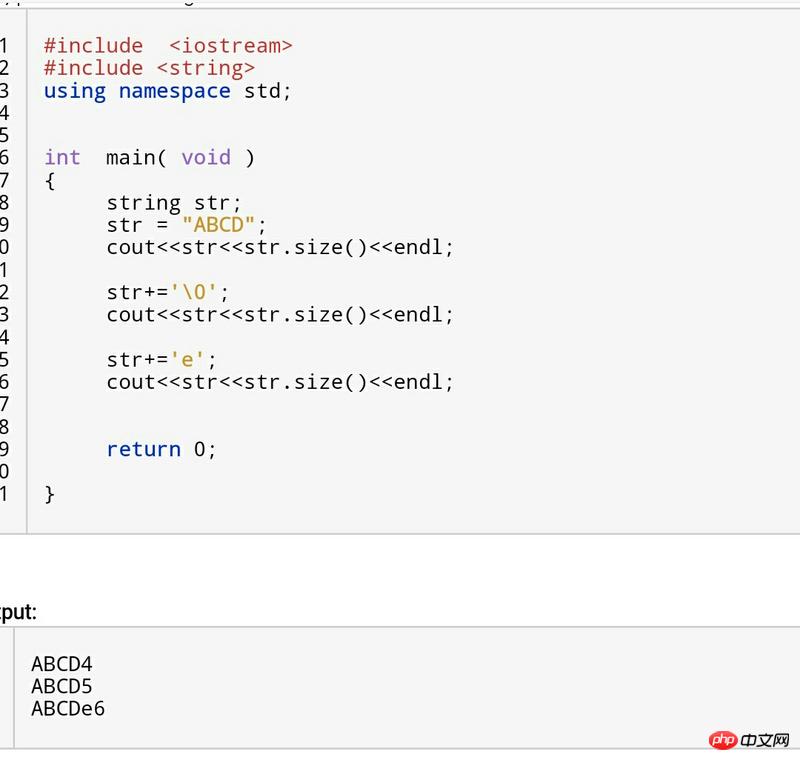大家讲道理2017-04-17 13:46:57

先上圖
string 類型把' 0'當做普通字符處理,長度加一,可見' 0'不是結束字符,不含有特殊功能,string末尾不需加' 0'
C語言中沒有string類型,而是用字元陣列代替,一般字元陣列可以不確定長度
char * string = " ABCD" ,編譯器靠什麼知道字串結束,一般在後面加' 0 '
高洛峰2017-04-17 13:46:57
C++ 中的std::string和 C-style string 是兩種不同的字串,前者是標準函式庫中定義的一個類,後者是字元陣列的別名。
C-style string:通常以�作為結尾。
std::string:標準中未規定需要�作為字串結尾。編譯器在實作時既可以在結尾加上�,也可以不加。但是,當透過c_str()或data()(二者在C++11 及以後是等價的)來把std::string轉換為const char *時,會發現最後一個字符是�(原因見文末附錄)。
C-style string 中一般不能包含�字符(因為這個字符被當作表示字符串結束的特殊字符處理了),如果包含這個字符,那麼其後的字符將會被忽略。即:
char s[] = "abstd::string s{'a', 'b', 'template<
class CharT,
class Traits = std::char_traits<CharT>,
class Allocator = std::allocator<CharT>
> class basic_string;
', 'c'};
//std::string s = "abstring s{'a', 'b', 'rrreee', 'c'};
cout << s.size() << endl; // 输出 4
s += 'rrreee';
s += 'd';
cout << s.size() << endl; // 输出 6
c"; // 这里由于是从 C-style string 构造 std::string,所以仍然会忽略 rrreee 之后的字符
cout << s << endl; // 输出 ab c
c";
cout << s << endl; // 输出 ab而std::string沒有這個限制。即:
透過c_str()或data()(二者在 C++11 及以後是等價的)來把std::string轉換為const char *時,會發現最後一個字元是�。想理解這個問題需要一點背景知識:
一,std::string 是 std::basic_string<CharT, Traits, Allocator>這個模板的特例std::basic_string<char>。即模板:
中的參數CharT為char時的特例。
二,s.size()會回傳std::string中字元的個數,即:
三,使用[]運算子(即std::basic_string::reference std::basic_string::operator[](size_type pos);)取得std::string中的字元時,其字元的範圍pos是從0到size()。其中0到size()-1是所儲存的字符,而對於pos == size()有以下規定:
意思是當存取If
pos == size(), a reference to the character with valueCharT()(the null character) is returned. For the first (non-const) modion, the behavior is undefined if this ifieder
時,會回傳s[s.size()]的回傳值的引用,而CharT()對於CharT是std::string,且char回傳的是char(),所以�00會回傳s[s.size()]。 �
或c_str()(data())傳回的指標存取字串時,其效果為:const CharT* c_str() const;
Returns: A pointersuch that
pfor eachp + i == &operator[](i)in [i,0].size()
即p[s.size()]等價於p + s.size()等價於&s.operator[](s.size())等價於s[s.size()],所以會發現回傳值是�。
巴扎黑2017-04-17 13:46:57
c語言用char*指標當字串時,在讀取字串時需要一個特殊字元0來標記指標的結束位置,也就是通常認為的字串結束標記。
而c++語言則是物件導向的,長度資訊直接被儲存在了物件的成員中,讀取字串可以直接根據這個長度來讀取,所以就沒必要需要結束標記了。而且結束標記也不利於讀取字串中夾雜0字元的字串。
参照std::string的实现 bits/basic_string.h大家讲道理2017-04-17 13:46:57
String本身是封裝過的,會把'
#include <iostream>
#include <stdio.h>
#include <string>
using std::string;
using namespace std;
void test1(){
string s1 = "Hello";
const char * v1 = s1.data();
printf("0x%.2x\n", v1[s1.size()]);
string *s2 = new string("Hello");
const char * v2 = s2->data();
printf("0x%.2x\n", v2[s2->size()]);
}
void test2(){
string s1 = "Hello";
const char * v1 = s1.c_str();
printf("0x%.2x\n", v1[s1.size()]);
string *s2 = new string("Hello");
const char * v2 = s2->c_str();
printf("0x%.2x\n", v2[s2->size()]);;
}
int main()
{
test1();
test2();
return 0;
}